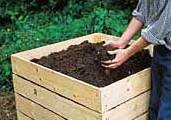|
|
|
|
If you live in area of the country with hot, dry summers and Compost, an additive which you can easily generate with inexpensive and readily available materials found around most homes, is a valuable enrichment to the soil. In addition, it helps to loosen hard clay soil and helps build up moisture in sandy, weak soil by retaining organic compounds. Likewise, mulch is essential to preserving plant life in dry areas. By layering it around your plants, organic mulch such as pine bark and other substances readily available at your local nursery or landscaping retailer, can help retain moisture around root systems, as well as protecting them from the burning effects of the sun. Not to be ignored is the fact that mulch can also add valuable nutrients and minerals to your soil. If your property is located in an area with an abundance of pine trees or find your lawn covered with leaves every fall, those sources might supply you with all the mulch you need. Just rake and bag the fallen pine straw or leaves and spread this resource around your flower beds and shrubs. Another added benefit of gathering your own mulch is the fact that you are protecting the environment by reducing the amount of material being sent to our landfills. Another possible use for all those leaves that you rake each fall is to make your own compost. And you can do so without purchasing any expensive piece of equipment, such as a compost bin, tumbler or activator. Just take all those leaves, along with grass clippings that you accumulate and pile them in alternating layers of green and brown. As you stack them, lightly spray each layer with a garden hose, making sure that you can the pile moist, not soggy. Of course, you will want to select a spot that is somewhat out of sight and make sure to place boards or something stable around the pile to keep it contained. The layers should be about three to four feet high. To accelerate the process, you can spread a little fertilizer over the top. You can also add food scraps to the pile, but if you live in an area where small wildlife might be attracted by food odors, that idea may create somewhat of nuisance. However, a compost heap is a great place to dispose of those coffee grounds that accumulate each day. After you get everything set up, all that is required is to turn the pile periodically, preferably every three
to four weeks, making sure to move the bottom to the top of the pile and the top to the bottom. It won't be long before
you notice that the center of the pile is beginning to heat up, which causes the decomposition of the material. Although the
process doesn't happen overnight, you will be surprised how quickly you have a tremendous source of soil enrichment for
your garden...and at hardly any cost. . The internet is full of great resources for learning more about composting and building a compost bin. You might
want to start with these: Composting 101 and How To Compost
|
 increasingly harsh periods of serious drought conditions, trying to maintain a bountiful cottage garden can be a somewhat
arduous task. However, the use of mulch and compost can be particularly helpful in offsetting the rigors of the blazing sun
and a lack of adequate natural moisture for your garden.
increasingly harsh periods of serious drought conditions, trying to maintain a bountiful cottage garden can be a somewhat
arduous task. However, the use of mulch and compost can be particularly helpful in offsetting the rigors of the blazing sun
and a lack of adequate natural moisture for your garden.